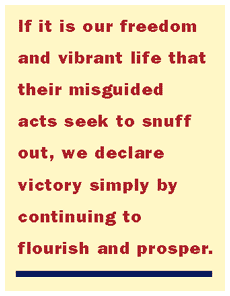by Sky Dayton
(Originally published Summer 2001)
At this time of year, students all across the nation are preparing to graduate into the real world. For many Internet companies—after a wild, two-year education—that graduation has already taken place. For me, 1999 was both a great and strange year. Great because EarthLink continued to boom. Strange because of the stock market euphoria enveloping the Internet world.
There was something in the air that year, something youthful, wild, and intoxicating. Myopic investors besotted with optimism threw money recklessly at just about any company that had anything to do with the Internet. Federal Reserve Chairman Alan Greenspan put it best when he described investor glee during that period as "irrational exuberance."
CLASS OF MISFITS, MALCONTENTS, AND MAESTROS
1999 was like senior year of high school for Internet companies. School is a funny thing—success and popularity are determined by a set of social laws that have nothing to do with the outside world. Note how there's often an inverse relationship between popularity in school and success in later life. The prom queen bags groceries at the local supermarket, while the geek who never quite fit in runs one of the world's largest companies. (I was a relatively unpopular gawky kid voted "most likely to succeed" by my fourth-grade class—I'll let you decide to which category I belong.)
2000 saw the Internet graduate into the real world. A class of companies was thrust out of their protected pale into the glaring sunlight of reality. Weak, one-dimensional adolescent enterprises that once easily made great headlines were now forced to get a job.
Here we are in 2001 and reality is harsh. Finally! Because when the stock market responded solely to buzz and rewarded companies with zero revenue and zero chance of future profitability, it cheapened the hard work of legitimate entrepreneurs and companies with real business models. For me, graduation to reality has been a welcome, if ugly, process.
DEATH OF "FREE"
While day traders made a killing on Internet stocks in 1999, it was an agonizing year for entrepreneurs with sound business models. Too much capital flowed into too many Internet companies, increasing competition for the handful of enterprises that insisted on approaching their market sensibly. Companies that couldn't find any other way to differentiate themselves competed solely on price, giving away service to gain customers. And investors played along by plugging the holes in their business models with barrels of stock market cash.
The "free" ISP, born in 1999, serves as the most infamous example of this indiscretion. While there is precedent for a 100 percent advertiser-supported medium, such as television and radio, the costs of providing an ISP service are well above the advertising revenue possible today. Any neophyte CFO can tell you that. But investors turned the other cheek and pumped billions into free ISPs. Today, most of them are out of business and billions are lost, but not before, at least temporarily, driving up the cost of doing business for EarthLink and other prudent ISPs with sound models.
THE FUTURE: RETURN TO REALITY
The stock market downturn of 2000, which continues thus far in 2001, has already purged weaker companies (like many of the free ISPs) from the system. And it isn't over yet. But while painful for all, this return to reality is a blessing for real companies. 
Commercial enterprises exist to provide a needed product or service in order to make a profit. Every now and then, the product or service can have a major lasting, positive impact on the world and be incredibly profitable. The Internet promises this combination, which is why it's so fun to be a part of this industry.
The Internet is an entrepreneur's dream. Here we have relatively low barriers to entry (it's easier to set up an Internet business than most other types), a service that is in insatiable demand the world over, and a technology that lowers the costs of doing business in just about any industry it touches.
In the long run, this means great profits for well-run Internet businesses. I've written in this column before that the Internet was still a "ground floor" opportunity for entrepreneurs and investors. I believe it even more, now that the competitive environment is healthier.
PEERING THROUGH THE FROTH
But we need a healthy view of the Internet industry. The press that once lauded anything labeled "dot com," in a 180-degree reversal, now delights in tearing apart all Internet companies and gleefully reports on firms closing up shop and going out of business.
The "irrational exuberance" of investor sentiment that Greenspan warned of has been replaced by "irrational pessimism." The thinking used to be: "It will always be this good." Now it's: "It will always be this bad." Both viewpoints are wrong.
So what is really going on here? To see it, one must look below the superficial froth of the stock market and newspaper headlines. Underneath, there's an undeniable current that has been flowing in the same direction since 1993: The Internet is fundamentally changing the way business is done and the way people interact, every day.
Regardless of stock valuations, financial market conditions, and anything anyone in the press has to say, more people are using the Internet to do more things more and more of the time. Since the Internet began its boom in 1993, the number of Internet users in North America has exploded to 120 million today, with nearly 250 million Internet users worldwide. That's impressive growth by any standards, and it shows no signs of letting up anytime soon. This means that the Internet isn't a fad or a bubble or any other transitory phenomenon. The Internet represents a basic shift in the way people do things.
Since the earliest computers were created, the goal of information technology has been to remove the excess time and space from personal and business activities. The first word processors made it much faster and easier to produce high-quality documents. The first home accounting software meant people could spend less time balancing their checkbooks. The first office email program meant people could send messages to each other without trucks and airplanes.
The Internet is the culmination of information technology. It is a way for people everywhere in the world to communicate with each other instantly. It is an infinitely large warehouse of nearly all information in existence. It is a public forum for debates on every topic imaginable. It is the only medium for businesses to directly and immediately interact with their customers. As it continues to grow, it will be the most pervasive communications medium of the 21st century.
The euphoria of 1999 is now long past, and the pessimism that followed may seem like it will never end. But it will. It takes many, many years to build an industry, and the Internet is just starting to mature. Much has happened, but this is only the beginning.




































